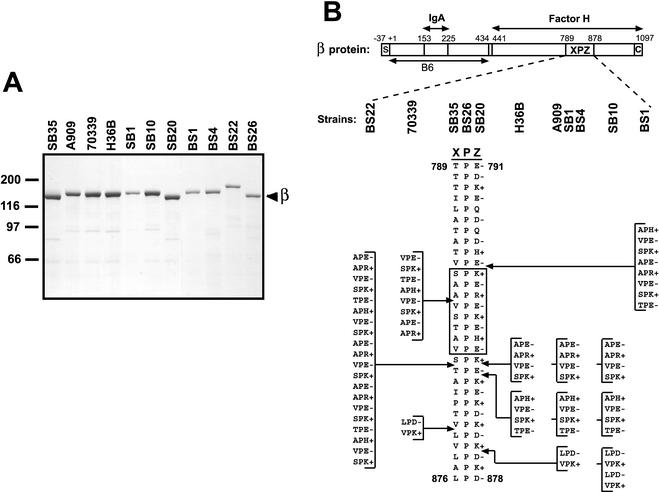FIG. 1.
Size and sequence variability in the XPZ region of the β protein. (A) Analysis by SDS-PAGE of β proteins expressed by 11 different GBS strains. These β proteins were isolated by incubating washed bacteria at elevated pH, a procedure that allows recovery of almost pure β protein (35). The major band at ∼125 kDa represents the β protein (see text). (B) Schematic representation of the streptococcal β protein and of the proline-rich XPZ region. Binding sites for human IgA-Fc and factor H are located in the N- and C-terminal halves of β, respectively, as indicated. The XPZ region, which is located in the C-terminal part of the protein, is composed of tandemly arranged three-residue XPZ motifs, in which the first residue (X) is uncharged, the second residue (P) is a proline, and the third residue (Z) is almost invariably charged. Moreover, the third residue is alternately of positive and negative charge, as indicated. The XPZ region is not required for binding of factor H but may enhance binding of this ligand (3; T. Areschoug, unpublished data). The region designated B6 represents an N-terminal fragment of β used to make antiserum (see text). S, signal peptide; C, C-terminal membrane anchor. The numbers refer to amino acid positions in the processed protein, with numbering according to Hedén et al. (19). The lower part of the figure shows the sequence of the XPZ region in the 11 different β proteins analyzed. Strain designations are indicated at the top. The different XPZ sequences may all be derived from the shortest sequence by the addition of blocks containing multiples of six amino acid residues, as indicated. For example, the amino acid sequence in strain SB10 can be derived from that in strain SB35 by the addition of three 12-residue blocks; the first two of these blocks are the same as those indicated for strain H36B. Due to the periodic sequence of the XPZ region at the protein and DNA levels, other sites of insertion are also possible. The boxed region corresponds to a synthetic peptide used for CD analysis and for raising antiserum to the XPZ region.

